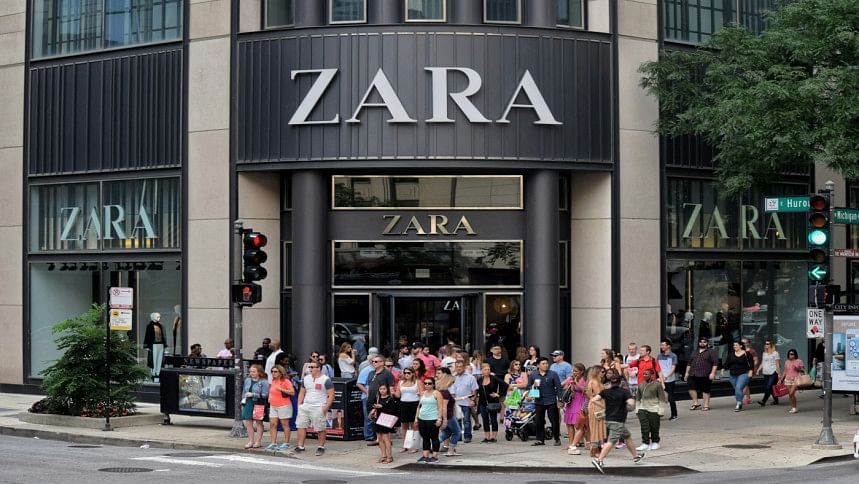Inditex’s golden era is coming to an end

Shein is turning into the fast fashion industry's bogeyman. As the Asian retailer prepares for a possible New York stock market listing, sector leader Inditex is so far dismissing the threat the disruptor poses to the Spanish group's rich valuation. As the Singapore-based upstart quickly adapts to its Western customers' needs, the 133 billion euro Zara owner has few obvious lines of defence.
Inditex CEO Óscar Garcia Maceiras is facing a challenge that the entire retail industry is grappling with. Shein and other low-price online retailers like Temu are leveraging their cheap Chinese suppliers to win market share against Western brands with extensive store networks.
The Asian firms' ability to quickly respond to customer desires via highly engaging smartphone apps while keeping inventory and costs down is threatening to upend the retail hierarchy where Inditex has long reigned supreme.
Maceiras, a Spanish lawyer, took the helm of the family-controlled company in 2021, succeeding veteran Pablo Isla, who had overseen the retail giant since 2005. Three years on, Maceiras, flanked by the founder's daughter Marta Ortega as chair, appears to be at the crest of a particularly strong wave.
Inditex has delivered compound annual sales growth of nearly 8 percent since 2015, despite the pandemic; rival H&M only managed to lift its top line by 5 percent a year during the same period.
The Spanish player, which controls brands like Massimo Dutti and Pull & Bear, has also become more profitable: its already healthy operating margin increased to nearly 19 percent from 17.7 percent over the decade.
Maceiras can take credit for shepherding Inditex through Covid-19 and rampant inflation. He continued to bet that the retailer's large city-based flagship stores would lure Zara's key constituency of 25- to 34-year-old women, and that this slightly more affluent cohort would be more willing to accept higher prices than cash-strapped Gen Z shoppers.
But the CEO has also been careful too. In the United States, for instance, Zara has hiked average apparel prices by 11 percent since 2022, less than the over 20 percent increases at rivals H&M and Mango in the same period, reckons Krista Corrigan, a retail analyst at EDITED.
Despite the apparent success, there are elements of Shein's business model that could threaten Inditex's dominance. To start, while a third of Zara's customers are women over 30, a similar proportion are in their twenties. But this younger group is also hoovering up $5 tops and handbags.
For now, patchy financial results from H&M as well as Western online retailers like ASOS and Boohoo suggest Shein is mainly luring customers from cheaper rivals.That may quickly change. Shein has started to go after Inditex's market by targeting working women with its premium but affordable business and social wear under the upmarket label MOTF, which includes 100 percent silk dresses and was launched in 2021. If the quality of Shein's offering continues to improve, and the company manages to keep prices low, its loyal fans may never graduate to Inditex brands.
The European grocery market offers a cautionary tale. Established supermarkets once viewed German discounters Aldi and Lidl through the same lens as clothing retailers see Shein. They dismissed budget chains as giving customers a low-quality, restricted offering which would therefore never make inroads in the middle market. But after the 2008 financial crisis shoppers became more cost-conscious and Aldi and Lidl invested heavily in their product range.
In the past 10 years the two German players have expanded their share of the UK grocery market by a combined total of nearly 11 percentage points, according to data from Kantar, opens new tab. All the traditional grocers, including market leader Tesco have lost ground. The same dynamic could play out in apparel.
Inditex is not sitting still. It's attempting to fend off competition from Shein by expanding its low-price label called Lefties, which once sold excess dresses and bags from Zara. In what looks like a race to the bottom, the Spanish group is now designing clothes specifically for this outlet.
A smarter move would be to copy the best bits of its Asian rival's model. The cheap fashion retailer's hottest selling point is its ability to engage digitally with customers. Shein became the most downloaded shopping app in the US in 2022, beating out Amazon.com and Walmart, according to data from Apptopia. Zara did not even feature in the top 10.
Christina Fontana, Shein's senior director in charge of brand operations, told the World Retail Congress last month young women come to the site and app multiple times a day to "play".Inditex's growth strategy seems to focus on revamping stores and connecting its online offering with its physical outlets. That will keep its existing customer base engaged. But to appeal to a younger audience, it may need to spend some of its 11 billion euro cash reserve to improve digital interaction.
Zara could also use artificial intelligence to track the popularity of garments, instead of its current model of relying more on store managers. Shein uses AI, opens new tab to analyse data like web searches and social media posts which are then sent to product designers. This means a new garment could be produced within days rather than weeks, and allows the retailer to keep inventory at a minimum.
Shein's rapid advance may be curtailed by regulation. In Europe, lawmakers are working on plans to tackle fast fashion waste. But while the goal is well-intentioned, devising rules to tackle discarded garments is likely to take years.
Meanwhile, Inditex has no obvious M&A solution for its vulnerabilities. The Spanish retail giant has long dismissed using its cash to buy rivals or expand into new markets. It instead keeps its growing reserves for a rainy day. Investors appear to be pricing in a threat, though. Inditex shares trade on less than 23 times expected earnings for the next 12 months, below its 10-year average of more than 24 times, LSEG data shows.
Sticking to its knitting may have worked for Inditex in the past, but the danger is that upstarts like Shein edge into the mid-market. The Spanish giant has few levers to pull to prevent such an eventuality.

 For all latest news, follow The Daily Star's Google News channel.
For all latest news, follow The Daily Star's Google News channel. 







Comments